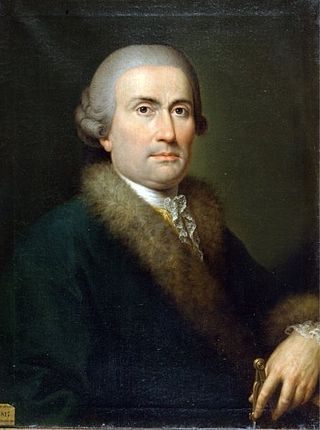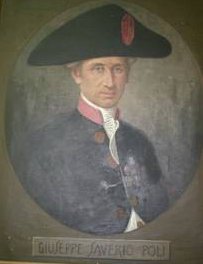Related Research Articles

Pietro Alessandro Guglielmi was an Italian opera composer of the classical period.

Gaetano Filangieri was an Italian jurist and philosopher.

Giuseppe Gazzaniga was a member of the Neapolitan school of opera composers. He composed fifty-one operas and is considered to be one of the last Italian opera buffa composers.

San Lorenzo Maggiore is a church in Naples, Italy. It is located at the precise geographic center of the historic center of the ancient Greek-Roman city, at the intersection of via San Gregorio Armeno and via dei Tribunali. The name "San Lorenzo" may also refer to the new museum now opened on the premises, as well as to the ancient Roman market beneath the church itself, the Macellum of Naples.

Vincenzo Cuoco was an Italian writer. He is mainly remembered for his Saggio Storico sulla Rivoluzione Napoletana del 1799. He is considered as one of the precursors of Italian liberalism and the realist school. Cuoco adapted the critique of political rationalism of Edmund Burke and Joseph de Maistre for liberal ends, and has been described as a better historian than either of them. He influenced many subsequent Italian intellectuals, from Ugo Foscolo and Alessandro Manzoni to Bertrando and Silvio Spaventa to Benedetto Croce and Antonio Gramsci.

The Archdiocese of Naples is a Latin archdiocese of the Catholic Church in southern Italy, the see being in Naples. A Christian community was founded there in the 1st century AD and the diocese of Naples was raised to the level of an Archdiocese in the 10th century. Two Archbishops of Naples have been elected Pope, Paul IV and Innocent XII.

Giuseppe Spinelli was an Italian cardinal. He was Prefect of the Congregation for the Propagation of the Faith

Giuseppe Piermarini was an Italian architect who trained with Luigi Vanvitelli in Naples and designed the Teatro alla Scala in Milan (1776–78), which remains the work by which he is remembered. Indeed, il Piermarini serves as an occasional journalistic synonym for the celebrated opera house. Piermarini was appointed professor in the Academy of Fine Arts of Brera, better known as Brera Academy, Milan, when it was formally founded in 1776.

Giuseppe Saverio Poli was an Italian physicist, biologist and natural historian.

Giuseppe Santarelli (1710–1790) was an Italian castrato, composer, choir conductor, voice teacher, and Roman Catholic priest. He was named a knight of the Sovereign Military Order of Malta.
Giuseppe Leggiadri Gallani was an Italian poet and dramatist. He was a native of Parma in the era of the rule of the Farnese family.
Tito Angelini (1806–1878) was an Italian sculptor and leader of the Academy of Fine Arts in Naples, where he was born and died.

Costanzo Angelini was an Italian painter, engraver, and restorer of the Neoclassical style.

The church of Santi Severino e Sossio and the annexed monastery are located on via Bartolommeo Capasso in Naples, Italy.
Paolo Girgenti was an Italian painter of the late 18th and early 19th-centuries, active in Naples.
Raffaele Mattioli was an Italian painter, active in his native Naples.

Luca de Samuele Cagnazzi was an Italian archdeacon, scientist, mathematician, political economist. He also wrote a book about pedagogy and invented the tonograph.

Marcello Papiniano Cusani was an Italian archbishop, professor of both civil law and canon law as well as founder and rector of the University of Altamura.
Annibale Giuseppe Nicolò Giordano was an Italian-French mathematician and revolutionary.

Antonio Bulifon (1649-1707) was a French printer working in Naples. As a publisher Bulifon was "fundamentally important for the diffusion of women's poetry" in Italy.
References
- ↑ San Sebastiano al Vesuvio: Un itinerario storico artistico e un ricordo di Gaetano Filangieri by Bernardo Cozzolino, Publisher Poseidon, Naples (2006); page 91.
- ↑ Dizionario biografico universale, Volume 5, by Felice Scifoni, Publisher Davide Passagli, Florence (1849); page 152.